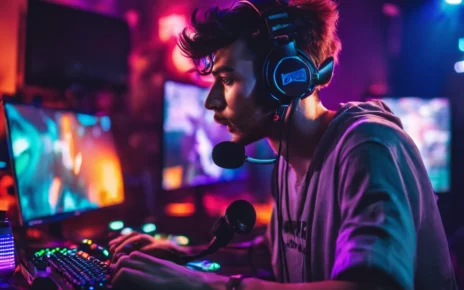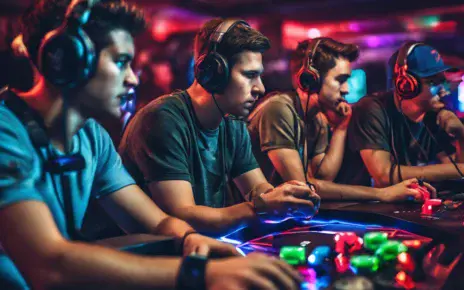Gaming equipment isn’t just an investment; it’s your gateway to immersive worlds and high-stakes adventures. Whether you’re a casual player or an esports competitor, maintaining your gaming gear is essential for maximizing performance, extending longevity, and preventing costly breakdowns.
Neglecting maintenance can lead to performance issues, overheating, and even permanent damage, impacting your overall gaming experience. This comprehensive guide covers everything from cleaning practices to troubleshooting tips to help keep your setup in peak condition.
Why Regular Gaming Equipment Maintenance Matters
Gaming hardware—from consoles and controllers to graphics cards and headsets—plays a crucial role in how smoothly your gaming sessions run. Over time, dust accumulation, overheating, and software issues can significantly degrade performance. Regular maintenance ensures:
- Consistent performance: Smooth gameplay without lag or stuttering.
- Longer lifespan: Extends the durability of expensive gaming gear.
- Reduced malfunctions: Fewer unexpected crashes or hardware failures.
- Enhanced gaming experience: Optimal performance for immersive gameplay.
Think of maintenance as tuning a sports car—keeping everything running efficiently ensures the best possible experience every time you play.
Essential Cleaning Practices for Gaming Hardware
Dust and grime are silent enemies, affecting everything from responsiveness to overheating risks. Implementing routine cleaning habits will keep your setup looking great and functioning flawlessly.
Cleaning Your Console or PC
- Exterior Cleaning: Use a microfiber cloth to wipe the surface, preventing dust buildup.
- Vents & Fans: Dust buildup can cause overheating. Use compressed air to remove debris from cooling fans and air vents.
- Ports & Cables: Check USB, HDMI, and power ports for dust or loose connections. Use a soft brush or air duster to clean them.
Cleaning Your Controllers & Accessories
- Controllers: Wipe with a microfiber cloth and a small amount of isopropyl alcohol to remove dirt and bacteria.
- Headsets: Clean ear cushions with gentle soap and water. Use disinfectant wipes on headbands and microphone covers.
- Keyboards & Mice: Shake out debris and use compressed air for hard-to-reach areas. Clean keys with cotton swabs and alcohol.
How Often Should You Clean?
- Weekly: Wipe down controllers, keyboards, and headsets.
- Bi-weekly: Dust off your PC/console exterior.
- Monthly: Deep clean vents, fans, and ports.
Temperature Control: Preventing Overheating & Performance Issues
Overheating is one of the biggest threats to gaming hardware. Excess heat can lead to system slowdowns, crashes, and even permanent hardware failure.
Signs Your System is Overheating
- Loud fan noise – Fans running at full speed constantly.
- Sudden shutdowns – Your PC or console turning off unexpectedly.
- Stuttering or frame drops – Gameplay becoming sluggish.
How to Prevent Overheating
- Ensure Proper Ventilation: Keep your gaming setup in an open area with good airflow.
- Clean Fans & Heatsinks: Use compressed air to remove dust buildup inside your console or PC.
- Use Cooling Accessories: Laptop cooling pads or additional case fans can help regulate temperatures.
- Monitor System Temperature: Use software like MSI Afterburner, HWMonitor, or SpeedFan to keep track of heat levels.
Proper Storage Solutions for Maximum Longevity
Storing gaming equipment properly prevents damage and extends its lifespan. Here are some best practices:
Game Consoles & PCs
- Store in a cool, dry place, away from direct sunlight and heat sources.
- Use a dust cover when not in use to prevent buildup.
- Keep your system elevated to ensure optimal airflow.
Controllers & Accessories
- Organize controllers, headsets, and keyboards in storage racks or drawers.
- Use cable management tools like Velcro straps or clips to avoid wear and tangles.
- Avoid humidity – Moisture can cause internal corrosion. Consider using a dehumidifier if you live in a humid area.
Software Maintenance: Keeping Your System Running Smoothly
Software issues can be just as disruptive as hardware failures. Keeping everything up to date ensures your gaming experience remains seamless.
Best Practices for Software Maintenance
- Update Your Games & System Firmware: Patches often fix performance issues and security vulnerabilities.
- Clear Cache & Temporary Files: Free up space by deleting unused files and clearing game caches.
- Defragment Your Hard Drive (HDD Users): Improves loading times and performance.
- Backup Save Data: Use cloud storage or external drives to protect your progress.
- Run Antivirus & Malware Scans: Protect against harmful software that may slow down your system.
VR Equipment Maintenance: Keeping Your Virtual Reality Gear in Top Shape
VR gear requires special care due to its delicate optics and sensors. Here’s how to maintain your setup properly:
Cleaning Your VR Headset
- Lenses: Use a microfiber cloth with a lens-safe cleaning solution.
- Straps & Padding: Wash with mild soap and water to prevent bacteria buildup.
- Sensors & Cameras: Wipe down with a soft cloth to maintain tracking accuracy.
Storing Your VR Equipment
- Use a dedicated stand or case to prevent dust accumulation.
- Keep away from direct sunlight to avoid lens damage.
- Charge controllers regularly to ensure they’re ready for use.
Troubleshooting Common Gaming Equipment Issues
Even with great maintenance, occasional issues arise. Here’s a quick troubleshooting guide:
Hardware Issues
- Console Won’t Turn On: Check power cables and try a different outlet.
- Controller Not Connecting: Reset the controller and ensure firmware is updated.
- Overheating PC: Clean dust from fans, reapply thermal paste if necessary.
Software Issues
- Game Crashing or Freezing: Verify game files and update drivers.
- Slow Internet Connection: Restart your router or switch to a wired connection.
- Laggy Performance: Close background apps and optimize in-game settings.
Cultivating Long-Term Maintenance Habits
Building consistent habits will keep your gaming setup in peak condition.
Simple Maintenance Routine
- Daily: Wipe down controllers and keyboards after gaming sessions.
- Weekly: Check for software updates and dust off gaming equipment.
- Monthly: Deep clean fans, vents, and peripherals.
- Quarterly: Inspect cables, update storage backups, and reorganize accessories.
Gamify Your Maintenance!
- Set reminders for cleaning schedules.
- Create a checklist for maintenance tasks.
- Make it a team effort if gaming with friends or family.
Final Thoughts: Invest in Longevity for Better Gameplay
Caring for your gaming equipment isn’t just about preventing breakdowns—it’s about ensuring smooth, uninterrupted gaming sessions. With regular cleaning, temperature control, proper storage, and software maintenance, your gear will stay in excellent shape for years to come.
By following these best practices, you can maximize your gaming experience and avoid the frustration of unexpected failures. Happy gaming, and may your setup always be battle-ready!




